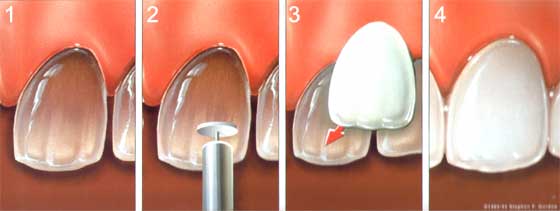Dental Veneers and Lumineers (no prep veneers)
A porcelain laminate veneer is a thin layer of dental ceramic material that is fixed to the outer surface of a tooth with a special resin adhesive. In short, dental veneers replace a thin layer of dental enamel creating a perfect aesthetic appearance. They enhance teeth cosmetically by masking a variety of minor to moderate dental imperfections. Working with dentists to pick an appropriate shade of porcelain, dental technicians can skillfully replicate natural enamel. Veneers do not stain the way teeth do, and can last seven to 20 years or even longer. That's because porcelain is hard, strong, durable, translucent in an attractive, glass-like way, and highly resistant to chemical attack.
Benefits of Veneers
Veneers can drastically improve the cosmetic appearance of teeth. Here are some conditions that are possible to repair with veneers.
Align Teeth
Straighten crooked teeth
Provide ideal gum and tooth balance
Lengthen, or widen teeth
Close minor to moderate spaces
Correct stubborn discoloration that some tooth whitening may be unable to correct
Fill chipped teeth
Correct minor bite problems
Give uniform, even sizing and presentation of all teeth
Dental Veneers
Designed for years of use, Dental Veneers are a great cosmetic solution.
How long do veneers last?
Veneers are designed to last from 5-12 years and in some cases can last as long as 20+ years. Porcelain veneers are strong enough to withstand normal flossing and brushing with any non-abrasive fluoride toothpaste; they should be cared for in the same manner as completely natural teeth. However, porcelain is a glass and like all glass, veneers can shatter if bent. Within reason, you can eat almost anything with veneers, but you wouldn't want to crack nuts against them or chew on bones. And if you grind your teeth at night, you may need to wear a night guard to protect your veneers.
What is the difference between Porcelain Veneers and Lumineers®?
Lumineers are one of the brands of veneers that do not require preparation of the tooth. They are much thinner than porcelain veneers however they are not as versatile and can not be used in all cases. Your cosmetic dentist will advise you whether you are a good candidate for this procedure
What Is the Process of Restoring Teeth with Veneers?
Illustration of dental veneer placement
If your dentist determines you are a good candidate for veneers, you can expect the process to take about two to three visits (including the initial consultation) over one to two weeks. The best way for your dentist to begin the process of designing your new smile is to create a model of your teeth, and then use it to make a provisional (temporary) set of veneers out of plastic. You can actually wear these for up to two weeks to see if you like the effect. Once you and your dentist agree on the form and the shade of your veneers, specifications are sent to a dental laboratory. There, our skilled technicians will fabricate custom veneers using a mold of your teeth, and bake it in an oven. Several layers are built up to mimic the translucency of real enamel. Before the veneer is bonded to the tooth, a small amount of the tooth's surface — 1 mm or less — is usually removed in a process known as reduction. This often requires local anesthetic. There is, however, a relatively new procedure requiring no tooth reduction, referred to as the no-drill or no-prep porcelain veneer. While veneers are most effective with minimal reduction (also called minimal prep), prepless veneers have the advantage of being reversible. But they are not appropriate in all situations.





